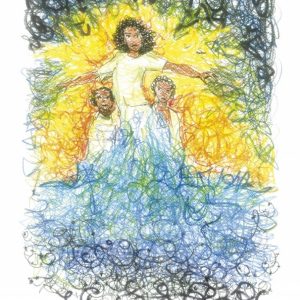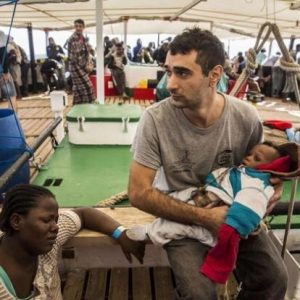
Story:
When I visited the island of Lampedusa in 2018, artist Francesco Piobbichi took me to a sun-drenched cemetery where we visited the grave of the young woman at the center of this picture. Her name was Welela. Here is her story in Francesco’s own words:
Welela was in prison in Libya when a gas cylinder exploded and burned her body.
She was not treated but loaded onto a dinghy. I think of her burned skin with the salt
of the sea and the pain that she could have felt and none would [ever] tell. I think of
her friends singing to say goodbye to her. Welela stared at Europe and at our European
rulers from a dinghy of fire over this sea of barbed wire. Welela will give us her eternal
accusing eyes.
From Drawings from the Border (Claudiana, p. 22)
Bible Reading: Galatians 6:9 (NRSV)
Paul encouraged the Galatian Christians to “not grow weary in doing what is right.” For the people who work on the front lines of the refugee crisis, this is easier said than done.
I wanted to let you hear Welela’s story in Francesco’s own words because, in the telling, his pain is so intertwined with her own. Just as the salt-water must have seared Welela’s wounds, so memories of tragedy sear the souls of the rescue workers. How can one not grow weary? How can one not be angry?
For Francesco, the drawings are a way to “harness that anger” without forgetting what made him angry in the first place. As he puts it, “Drawing means getting inside yourself to narrate what is happening inside you: A picture…becomes a key to open the door of a tale that crosses borders” (Drawings from the Border, p. vi). Perhaps it is also a key to not growing weary in doing what is right.
Discussion/Reflection:
- What part of Welela’s story is hardest for you to hear? Why?
- Sometimes the secondary traumatization experienced by those who work with victims of tragedy is called “compassion fatigue.” Have you ever experienced this or known someone who has? What was it like?
Action:
- The young man cradling a refugee baby in the photo below is a young Italian Protestant, Daniele Naso. This photograph was taken on his fifth volunteer assignment on a ship doing search and rescue operations on the Mediterranean. Pray for people like Daniele as well as for those they seek to help.

- Risk your own comfort to help someone else today.
Prayer: Help those who help, O Lord. May they draw from the inexhaustible well of your compassion, so that they may not grow weary of well-doing.
Welcoming the Stranger Series
In the last ten years more than 35,000 asylum seekers have died in the Mediterranean. Desperate to escape untenable situations in countries like, Syria, Eritrea, Sudan, and Somalia, refugees risk both life and livelihood to board rickety boats bound for what they hope will be a new life in Europe. Many of them die within sight of what they hoped would be the promised land.
Welcoming the Stranger is a devotional series designed to help Christians connect this unfolding humanitarian crisis in the Mediterranean with the Bible’s call to “welcome the stranger.” Recognizing that “the stranger” can sometimes be an abstraction that blinds us to the face of Christ, the series approaches the refugee crisis from a personal perspective. Each entry focuses on one person’s story, brought vividly to life by Italian artist and relief worker, Francesco Piobbichi. These stories are then linked to relevant Scripture, prayer, discussion, and action prompts.
Immigration is a hot topic around the globe, and the Bible passages in this series speak to wherever we are called to “welcome the stranger.” My specific interest in the Mediterranean context was sparked by a 2016 trip to the island of Lampedusa—a small island off the coast of Sicily that is the scene of so much hope and tragedy for refugees trying to enter Europe via small, unsafe boats. In addition learning about the situation there and the work being done by ecumenical groups like Mediterranean Hope, I spent significant time interviewing Francesco Piobbichi, whose art documents the stories of individual refugees and families who often die trying to reach safety. You can learn more about him and work through the following link: Francesco Piobbichi’s Artwork Each of his “snapshots” tells a story—sometimes of triumph, but often of tragedy: Piobbichi’s goal is to help people understand this large-scale human tragedy on a more personal level. My goal in this series is to use Piobbichi’s art as a starting point for Bible study and personal reflection/action.
